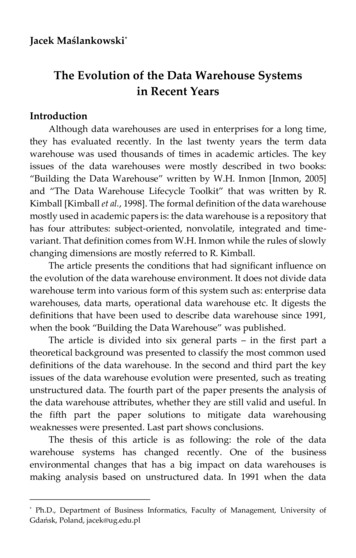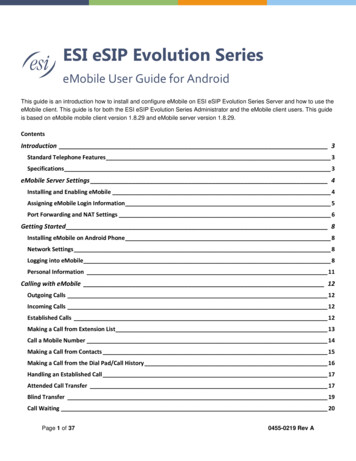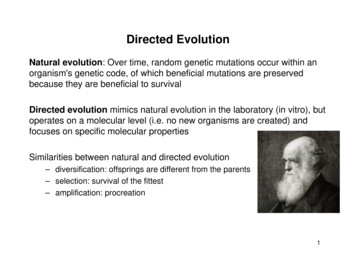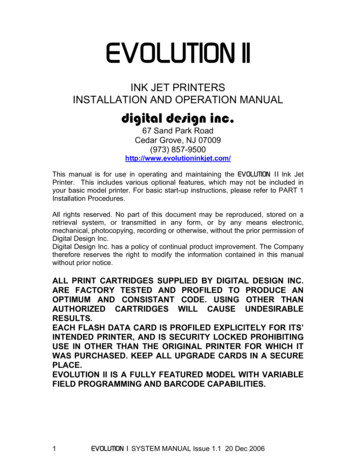
Transcription
Jacek Maślankowski*The Evolution of the Data Warehouse Systemsin Recent YearsIntroductionAlthough data warehouses are used in enterprises for a long time,they has evaluated recently. In the last twenty years the term datawarehouse was used thousands of times in academic articles. The keyissues of the data warehouses were mostly described in two books:“Building the Data Warehouse” written by W.H. Inmon [Inmon, 2005]and “The Data Warehouse Lifecycle Toolkit” that was written by R.Kimball [Kimball et al., 1998]. The formal definition of the data warehousemostly used in academic papers is: the data warehouse is a repository thathas four attributes: subject-oriented, nonvolatile, integrated and timevariant. That definition comes from W.H. Inmon while the rules of slowlychanging dimensions are mostly referred to R. Kimball.The article presents the conditions that had significant influence onthe evolution of the data warehouse environment. It does not divide datawarehouse term into various form of this system such as: enterprise datawarehouses, data marts, operational data warehouse etc. It digests thedefinitions that have been used to describe data warehouse since 1991,when the book “Building the Data Warehouse” was published.The article is divided into six general parts – in the first part atheoretical background was presented to classify the most common useddefinitions of the data warehouse. In the second and third part the keyissues of the data warehouse evolution were presented, such as treatingunstructured data. The fourth part of the paper presents the analysis ofthe data warehouse attributes, whether they are still valid and useful. Inthe fifth part the paper solutions to mitigate data warehousingweaknesses were presented. Last part shows conclusions.The thesis of this article is as following: the role of the datawarehouse systems has changed recently. One of the businessenvironmental changes that has a big impact on data warehouses ismaking analysis based on unstructured data. In 1991 when the dataPh.D., Department of Business Informatics, Faculty of Management, University ofGdańsk, Poland, jacek@ug.edu.pl*
42Jacek Maślankowskiwarehouse term has been defined by W. H. Inmon, unstructured datawere not concerned in the data warehouse. In Internet era, which growsimmediately in the turn of 20th and 21st century, there is a need ofincluding these data. This is one of the changes in the data warehouse, butnot the only, as it was written in further parts of this article.1. Theoretical backgroundAs mentioned in the introduction there are several definitions of theterm data warehouse, but the most often used in academic papers arebased on W.H. Inmon and R. Kimball.There are lots of books that use these definitions. For instancedefinition based on Inmon was used in [Humphries, 1999, p. 34],[Abramowicz et al., 2000, p. 7-8], [Ponniah, 2001, p. 23-24], [Malinowski,Zimanyi, 2009, p. 3], [Todman, 2001, p. 32-33]. This well-known datawarehouse definition (subject-oriented, non-volatile, integrated and timevariant) concerns the characteristics of the data in the warehouse not thedata warehouse system.That is why there are books that combine the definition of the datawarehouse based on Inmon with another definition, for instance based onMattison [Abramowicz et al., 2000, p. 7-8]. It is possible because Mattisondefined data warehouse as the objectives of the system: “ whoseprimary purpose is to extract information out of legacy systems, andmake it usable to business people, in the support of their efforts to reducecost and improve revenue”.Based on Hammergren “a data warehouse is a repository ofsubjectively selected and adapted operational data, which cansuccessfully answer any ad hoc, complex, statistical and analyticalqueries. It is situated at the centre of a decision support system (DSS) ofan organization and contains integrated historical data; both summarizedand detailed information – common to the entire organization ”[Prabhu, 2006, p. 1].There are also several books that use a bit modified definition basedon R. Kimball, for instance: a data warehouse is a large analytical databasewhich derives its data from a variety of production systems and isstructured for querying, reporting and analysis [Khan, 2003, p. 8].The definition based on Oracle documentation is as follows: a datawarehouse is a database containing data from multiple operationalsystems that has been consolidated, integrated, aggregated and
The Evolution of the Data Warehouse Systems in Recent Years43structured to support the analysis and decision-making process of abusiness [Hobbs, 2005, p. 4].Several researchers defined the data warehouse based on itsfunctional aspects. In that sense the data warehouse is an informationsystem that: provides an integrated and total view of the enterprise, makethe enterprise’s current and historical information easily available forstrategic decision making, makes decision support transaction possiblewithout hindering operational systems, renders the organization’sinformation consistent, presents a flexible and interactive source ofstrategic information [Ponniah P., 2001, p. 13].But the data warehousing systems were used before 1991 when theformal definition of the data warehouse was established. The first steptowards data warehousing was the fixed presentation of data. The aimwas to build a system on top of automation and controlling applications,an example of the first warehouse is based on Wal-Mart [Westerman,2001, p. 4] or IBM Ireland [Januszewski, 2008, p. 21].To conclude, data warehouse is still defined in three ways: concerning data, usually based on Inmon, as a system, based on its functionality.The most flexible definition is based on W. H. Inmon but it is very oftensupplemented with functional or system definition. One of the definitionsconcerning data warehouse as a system is based on R. Kimball.2. Data warehousing concepts in recent academic papersAn important step is to analyse the current practical aspects of thedata warehouse based on recent academic articles, reviewed byuniversities authorities. Table 1 shows the number of articles containingthe term “data warehouse” in its keywords or titles in well-knownresearch papers databases in last five years.Table 1. Number of articles concerning data warehousing issues in selecteddatabases in January 2008-April 2013Name of the databaseEBSCOhost (BusinessSource Complete)Web of ScienceSciVerseSource: Own elaboration.Number of articles46515959
44Jacek MaślankowskiThe next step was to analyse the context of these articles. It can befound that these articles mostly concern data warehouse designing issues,such as integrating issues, data cleansing, conceptual designing(including ontology-based design), security aspects, reporting issues,metadata managing, business intelligence and data mining mechanism.There are also several articles based on case studies that describe achallenges of the data warehouse implementations in differententerprises as well as surveys results of the data warehousesimplementations in business organizations.There has also been developed a concept of the streaming datawarehouse. The key issue is to combine the traditional data warehousesand data stream systems [Golab et al., 2012, p. 1092-1093]. This conceptwas mentioned several times in articles, concerning different aspects ofits functionality, including OLAP queries and scheduling.Another concept of the data warehouse that was tackled in researchpapers is real-time and near-real-time data warehouses. A real-time datawarehouse incorporates operational data changes in real time [Chen et al.,2011, p. 1150]. It collects a large number of streaming data. Thesewarehouses are mostly used in applications such as IP networkmonitoring, online financial trading or credit card fraud detection [Bateniet al., 2011, p. 757]. The difference between near-real-time and real-timewarehouse is that near real-time mechanism can identify whether the datawarehouse needs to be updated in real-time or near real-time, which iscalled right time. The key issue is not to update the warehouse directlyafter the evidence occurred, but to verify the quality of the data based onseveral measures, such as frequency of the data feed.There is also a concept called Active Data Warehouse. It is awarehouse that is refreshed online and achieves a higher consistencybetween the stored information and the latest data updates [Polyzotis etal., 2008, p. 976-977].The conclusion is that the data warehouse is still a strong researcharea for scholars and scientists. New concepts of the data warehouse aredeveloped and there is still a necessity to improve them.3. Key issues of the data warehouse evolutionWhat has been written in previous parts of this article, analyzingacademic papers in leading journals on IT and management, leads to the
The Evolution of the Data Warehouse Systems in Recent Years45conclusion that one of the most common used definition is based on W.H.Inmon’s book titled “Building the Data Warehouse”.There were lots of academic and brief news articles concerning datawarehouse evolution. In these papers it can be read about functionalaspects of this system, such as that enterprise data warehouse is the nextlogical step in the data warehouse evolution chain [Sinn, 2002, p. 31-32].It was also written that the data warehouse evolution is about changesand means to handle occurring changes [Papastefanatos et al., 2008,p. 444].But one of the key issues of the data warehouse evolution is relatedto adapting the warehouse to changing business environment. Using agilemethodologies such as Scrum and eXtreme Programming (XP) seems tobe the future of the data warehouse [Hughes, 2008, p. 1-3]. As we needdata quickly and there is a need to increase the functionality of the datawarehouse, the only way is to use a methodology that will allow us tobuild such systems very fast and in efficient way. The challenge is to adaptdata warehouses implementation methodology to be more flexible whichcan be done by using agile methodologies.In this analysis it is also not possible to omit the key position in thedata warehouse designers library which is “Building the DataWarehouse” written by W.H. Inmon. This book had several editions andthe fourth edition, that was printed in 2005, contains the following newtopics, important in todays’ data warehouse environment: Operational Data Store – the place for high-performance responsetime processing; unstructured data – the idea was to link structured and unstructureddata by text using a probabilistic match, a themed match; near-line storage that allows to extend data warehouse to infinity,because it allows storing the data in the low-performance andtherefore inexpensive disk storage [Inmon, 2005, p. 144, 308-310, 429].In 2006 a new approach called Data Warehouse 2.0 has beendeveloped by W. H. Inmon and others [Inmon et al., 2008, p. 9-11]. Thereare several differences between traditional data warehouse and theconcept named DW 2.0. But the most important difference that it reliesnot only on the structured data but also on unstructured, such as textdocuments. The Data Warehouse 2.0 should be treated as the new project,comparing to the previous written in the 4th edition of the “Building the
46Jacek MaślankowskiData Warehouse” that has just some proposals of matching and linkingunstructured and structured data.To conclude this and previous part of the article, the following issueshad the biggest impact on data warehouse evolution: need to store unstructured data, what is the result of increasednumber of data sources in enterprises, also adapting to Big Datamechanism should be considered, using agile methodologies as end users wanted faster implementationof the system to fulfil their changing requirements as well as usersbecome more sophisticated in their requirements, streaming and real-time data warehousing that need to create a highreliability and availability environment.4. Attributes of the modern data warehouse4.1. General viewAs it was mentioned in the introduction, based on W. H. Inmon thedata warehouse is a system with four attributes: subject-oriented, non-volatile, integrated and time-variant.In this chapter we will try to focus on changes within these attributes inrecent years.4.2. Subject-orientedBased on W. H. Inmon subject-oriented means that the data isconcentrated on subjects, such as customer, policy, premium, claim ininsurance company, not on applications as it is in operational systems[Inmon, 2005, p. 29].It depends on the way subject-oriented are considered but modernwarehouses still concentrates on various subjects. It is even when theapproach based on variable is used. The variable is a dimension table withattributes such as the name of the variable, subject, description etc. Eachvariable may concerns different subject but it is still subject-oriented, notoperational storage.But to conclude we can say that the data warehouse is stillsubject-oriented and there were no changes in this matter.
The Evolution of the Data Warehouse Systems in Recent Years474.3. Non-volatile dataIn Inmon we can read, that non-volatile means that once the data isloaded into the warehouse it cannot be changed [Inmon, 2005, p. 31-32].Based on the research made in Polish organisations that use datawarehouses, we can read that data are sometimes deleted, especiallywhen there is a new source with better quality or there is a decision thatthe data will not be used anymore in the warehouse [Maślankowski, 2008,p. 45-46]. Another issue is that data in the data warehouse sometimes haveto change, when there was a mistake or newer data is available. Inparticular when the data warehouse is based on macroeconomics data,such as inflation rate or GDP estimates that are usually corrected in a longperiod of time. The solution for this problem is to use versioningmechanism – to store different versions of data (newer or older), but forsome reasons it is too complicated and it is easier to update the data. Thereare also several new approaches in handling the issue of updating thevalue of a dimension or a fact [Papastefanatos et al., 2008, p. 444].Based on these facts, it can be said that there was a need to precisethe meaning of non-volatile attribute, but it is not the key issue of the datawarehouse evolution.4.4. Integrated dataIntegrated data means that the data is fed from multiple, disparatesources into data warehouse. Then the data is converted, reformatted andaggregated as well. As the result the data warehouse has a singlecorporate image [Inmon, 2005, p. 30].It is a general knowledge that the data gathered in the datawarehouse must be integrated. It is not possible to load data into onerepository of the warehouse that are not integrated, considering thewarehouse schema with common dimensions. However there were someconcepts of using unstructured data in data warehouses [Inmon, 2005,p. 305-330]. Although R. Kimball clearly wrote in his second edition of thebook “The Data Warehouse Lifecycle Toolkit” that the data in thewarehouse repository should be structured [Kimball, Ross, 2002, p. 7-8],the necessity of including unstructured data as a source was consideredby W. H. Inmon and in the 3rd edition of the book “Building the DataWarehouse”, that was published in 2005, Inmon showed how to storeunstructured data in the data warehouse. In the same time W. H. Inmonmade the new concept of the data warehouse called DW 2.0. In thisconcept the repository of the data warehouse was divided into two parts
48Jacek Maślankowskito store data: structured and unstructured. Significant role ofunstructured data is the result of the growing of social networks on theInternet.Therefore the main evolution in the data warehouse integrated dataissue is to integrate both structured and unstructured data.4.5. Time variantTime variant is an attribute of the data warehouse that was definedby W. H. Inmon as “every unit of data in the data warehouse is accurateas of some moment of time” [Inmon, 2005, p. 32].Each data warehouse designed in multidimensional model containsdata that referred to a specific period of time or at least specific timestamp. In that matter nothing has changed since the data warehouse hasbeen defined. There is no possibility to deploy a data warehouseenvironment in modern IT data warehousing systems such as MicrosoftSQL Server or Oracle without having time dimension in warehouseschema.5. Current trends to mitigate traditional data warehouse’s weaknessesTraditional data warehouse has several weaknesses that can bemitigated by new improvements in its design method. Issues to improvein data warehousing implementation can be divided into followinggroups: managing the changes in the data warehouse to reflect changingbusiness environment, dealing only with structured data, whereas more important are alsounstructured data, implementation agility.The first issue is to design the data warehouse to be flexible enough tomake changes in its subject and object scope without necessity ofmodifying its schema. For instance adding new data source to therepository can be one of these changes. Although lots has been done inthis area, e.g., Ralph Kimball has developed a concept called slowlychanging dimensions and William H. Inmon published the enhancedversion of the data warehouse called DW 2.0, there are still some lacks inthis matter. One of the ways to handle this issue is to use a variableapproach in designing a data warehouse [Maślankowski, 2013]. Theapproach based on variables focuses on each business fact as a variablethat can be simply described. The goal of the variable approach is to add
The Evolution of the Data Warehouse Systems in Recent Years49a new dimension table named Variable. This table should have at leastfew attributes (dimensions) such as the name of the variable, itsdescription, group and subgroup, the possible ways of calculating(aggregations, possible calculations), methods of retrieving the result,data source (if possible) and others if necessary. The aim of the variabledimension is to add new phenomenon from business environment, notonly new product but also some calculations, mathematical or statisticalcomputations and similar.The second issue is that the traditional data warehouse gathers onlystructured data. However, what has been mentioned before, W. H. Inmonpublished the concept of the new data warehouse called DW 2.0 that is infact the repository to integrate unstructured and structured data together[Inmon et al., 2008]. This approach has been positively evaluated and wasone of the subjects tackled by several researchers. There were also severaldifferent approaches to resolve this problem, e.g., a document warehousewhich was a concept of gathering unstructured documents and as aprototype was developed in late 90s. Its enhanced metadata, to bettermaintain and manage all unstructured documents, based on keywordsand content based retrieval mechanisms as well as cross-documentrelations [Tseng, 2005, p. 55-56], can be used not only to gather andanalyze text documents, but also to store and manage multimedia files[Ishikawa et al., 1998, p. 90-91].The third issue concerns the agility of its implementation. Based onthe research made by IDC the time needed to implement the datawarehouse is usually more than 18 months – this concerns 65-70% of DWimplementations [Bach et al., 2012, p. 147]. It was confirmed by the studyon data warehousing implementations in Polish organizations[Maślankowski, 2008, p. 44-45]. Therefore there is a need of minimizingthe total time of the data warehouse implementation as well as improveits flexibility, especially by using agile methodologies. There are someelaborations of the possibilities in implementing data warehouse by usingdifferent agile methodologies, such as XP, RUP, Scrum or Lean Agile[Sandler, 2010, p. 20], but they are still not widely used.Although this article focused only on these three issues of moderndata warehouses, in literature we can find several different aspects oflacks of the data warehouse concerning its data. Firstly, the hierarchiesare represented only based on balanced trees, what differentiated datawarehouse environment from the real world where hierarchies are
50Jacek Maślankowskiunbalanced. Secondly, data warehouse has not been still adapted to thespatial data. Thirdly, inclusion of the temporal data must be concernednot only in the fact table, but also by dimensions and hierarchies[Malinowski, Zimanyi, 2009, p. 1-2].Nevertheless, data warehouse proposed by W.H. Inmon andR. Kimball is still the most appropriate system for analytical purposes.The key issue is to mitigate the weaknesses by supporting the warehousewith the new approaches that were presented above.ConclusionAlthough lots has been written about data warehouses there is still aneed for improving existing methodologies of its implementation as wellas enhancing the data warehouse repository to gather unstructureddocuments.Based on that article it can be seen that the data warehouse is still aninteresting and valuable system for future research and studies in IT andmanagement area. The main challenges are to deal with structured dataand to make the warehouse more flexible. As it was written in theprevious part of this article, the goal is to use agile methodologies andcombine the data warehouse with the new approaches to gatherunstructured data.However, concerning unstructured documents, it can be said that thedata warehouse is not the proper repository to collect unstructured andwe should use different tool for this purpose. But looking into literaturewe can see that even W. H. Inmon has planned to enhance the datawarehouse to deal with unstructured documents, which is a DW 2.0project.There is still a need to evaluate the definition of the data warehouse.As it was written in this article, there are several elaborations, bothresearch papers and academic books that used several definition of thedata warehouse to ensure that the system will be correctly recognized byreaders.References1. Abramowicz W., Kalczyński P., Węcel K. (2002), Filtering the Web toFeed Data Warehouses, Springer-Verlag, p. 7-8.2. Bach M., Werner A., Duszeńko A. (2012), Selecting databasestructure based on the analytical processing optimization criteria
The Evolution of the Data Warehouse Systems in Recent Years3.4.5.6.7.8.9.10.11.12.13.14.51[in:] Studia Informatica, Vol. 333, No. 2A (105), Silesian University ofTechnology Press, p. 147.Bateni M., Golab L., Hajiaghayi M., Karloff H. (2011), Scheduling toMinimize Staleness and Stretch in Real-Time Data Warehouses, [in:]Theory of Computing Systems, Vol. 49, Issue 4, November 2011, p.757.Chen L., Rahayu W., Taniar D. (2011), Towards Near Real-Time DataWarehousing, [in:] 24th IEEE AINA, p. 1150.Golab L., Johnson T., Shkapenyuk V. (2012), Scalable Scheduling ofUpdates in Streaming Data Warehouses [in:] IEEE Transactions onKnowledge & Data Engineering, Jun2012, Vol. 24 Issue 6, p. 10921093.Hobbs L. (2008), Oracle Database 10g Data Warehousing, Elsevier,p. 4.Hughes R. (2008), Agile Data Warehousing. Delivering World-ClassBusiness Intelligence Systems using Scrum an XP, Ceregenics,p. 1-3.Humphries M., Hawkins M.W., Dy M.C. (1999), Data warehousing.Architecture and Implementation, Prentice HallInmon W.H. (2005), Bulding the Data Warehouse, Fourth Edition,Wiley Publishing Inc., p. 25, 31-32, 144, 308-310, 429.Inmon W., Strauss D., Neushloss G. (2008), DW 2.0. The Architecturefor the Next Generation of Data Warehousing, Morgan Kaufmann,Burlington, p. 9-14.Ishikawa H., Kubota K., Noguchi Y., Kato K., Ono M., Yoshizawa N.,Kanaya, A. (1998), A document warehouse: a multimedia databaseapproach, [in:] Database and Expert Systems Applications, 1998.Proceedings. Ninth International Workshop on Date of Conference:25-28 Aug 1998, p. 90-91.Januszewski A. (2008), Funkcjonalność informatycznych systemówzarządzania. Tom 2. Systemy Business Intelligence., WydawnictwoNaukowe PWN SA, p. 21.Khan A.H. (2003), Data warehousing 101. Concepts andimplementation., iUniverse, p. 8.Kimball R., Reeves L., Ross M., Thornthwaite W. (1998), The DataWarehouse Lifecycle Toolkit, Wiley Publishing, Inc.
52Jacek Maślankowski15. Kimball R., Ross. M (2002), The Data Warehouse Lifecycle Toolkit.Second Edition. The Complete Guide to Dimensional Modeling.,John Wiley and Sons, p. 7-8.16. Malinowski E., Zimanyi E. (2009), Advanced Data WarehouseDesign. From Conventional to Spatial and Temporal Applications,Springer-Verlag, p. 1-3.17. Maślankowski J. (2008), Using data warehouse systems in Polishorganizations (in Polish), [in:] Infobazy 2008. Systems, applications,services, p. 44-46.18. Maślankowski J. (2013), Managing methodological changes in thedata warehouses (in Polish), [in:] Yearbook of Economics CollegiumAnalysis 2013 (in printing)19. Sandler D. (2010), Best Practices for Applying Agile Techniques toData Warehouses, [in:] Business Intelligence Journal, Vol. 15 Issue 4,2010, p. 20.20. Sinn B. (2002), Enterprise Data Warehouse Is The Next Step In DataWarehousing, [in:] National Underwriter / Life & Health FinancialServices; 11/11/2002, Vol. 106 Issue 45, p. 31-32.21. Papastefanatos G., Vassiliadis P., Simitsis A., Vassiliou Y. (2008),Design Metrics for Data Warehouse Evolution, [in:] ER '08Proceedings of the 27th International Conference on ConceptualModeling, Springer Berlin Heidelberg, p. 444.22. Polyzotis N., Skiadopoulos S., Vassiliadis P., Simitsis A., Frantzell N.(2008), Meshing Streaming Updates with Persistent Data in anActive Data Warehouse, [in:] IEEE Transactions on Knowledge &Data Engineering, Jul2008, Vol. 20 Issue 7, p. 976-977.23. Ponniah P. (2001), Data Warehousing Fundamentals. AComprehensive Guide for IT Professionals, John Wiley & Sons, Inc.,p. 13.24. Ponniah P. (2010), Data Warehousing Fundamentals for ITProfessionals, John Wiley & Sons, Inc., p. 23-24.25. Prabhu C.S.R. (2006), Data Warehousing. Concepts, Techniques,Products and Applications, Prentice Hall, p. 1.26. Todman C. (2001), Designing a Data Warehouse: SupportingCustomer Relationship Management, Prentice Hall, p. 32-33.27. Tseng F.S. (2005), Design of a multi-dimensional query expressionfor document warehouses, [in:] Information Sciences, June 2005, Vol.174 Issue 1/2, p. 55-56.
The Evolution of the Data Warehouse Systems in Recent Years5328. Westerman P. (2001), Data Warehousing. Using the Wal-Martmodel., Academic Press, p. 4.AbbreviationsBI – Business IntelligenceDW – Data WarehouseGDP – Gross Domestic ProductIDC – International Data CorporationRUP – Rational Unified ProcessXP – eXtreme ProgrammingIT – Information TechnologyThe evolution of the data warehouse in recent years (Summary)The article shows the key issues of the data warehouse evolution in recentyears. It is divided into six general parts – in the first part a theoretical background was presented to classify the most common used definitions of the datawarehouse. In the second and third part the key issues of the data warehouseevolution were presented, such as treating unstructured data. The fourth part ofthe paper presents the analysis of the data warehouse attributes, whether theyare still valid and useful. In the fifth part the paper solutions to mitigate datawarehousing weaknesses were presented. Last part shows conclusions.Keywordsdata warehouse, business intelligence, business informatics
and The Data Warehouse Lifecycle Toolkit that was written by R. Kimball [Kimball et al., 1998]. The formal definition of the data warehouse mostly used in academic papers is: the data warehouse is a repository that has four attributes: subject-oriented, nonvolatile, integrated and time- variant. That definition comes from W.H. Inmon while the .











